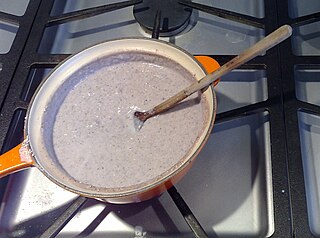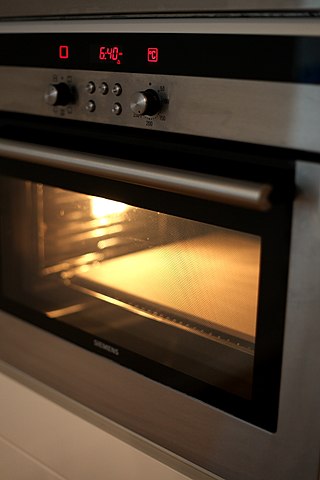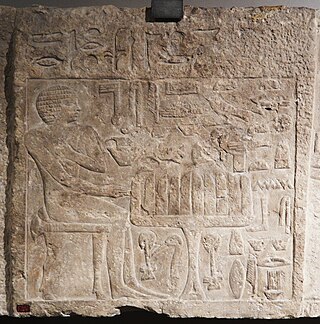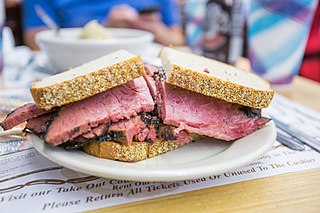 Piki Bread at a hotel restaurant in Santa Fe, New Mexico | |
| Type | Bread |
|---|---|
| Place of origin | United States |
| Region or state | Western United States |
| Main ingredients | Blue corn meal, ashes, water |
Piki is a bread made from blue corn meal used in Hopi cuisine.
 Piki Bread at a hotel restaurant in Santa Fe, New Mexico | |
| Type | Bread |
|---|---|
| Place of origin | United States |
| Region or state | Western United States |
| Main ingredients | Blue corn meal, ashes, water |
Piki is a bread made from blue corn meal used in Hopi cuisine.
Blue corn, a staple grain of the Hopi, is first reduced to a fine powder on a metate. It is then mixed with water and burnt ashes of native bushes or juniper trees [1] [2] [3] for purposes of nixtamalization (nutritional modification of corn by means of lime or other alkali). The thin batter is then smeared by hand over a large flat baking stone [4] that has been heated over a fire and coated with oil made from pounded seeds of the native American plants squash and sunflower, and also from the seeds of watermelon, which though originally from Africa, has been in the Americas for at least 500 years. [5] Piki bread bakes almost instantaneously and is peeled from the rock in sheets so thin they are translucent. [6] Several sheets of the bread are often rolled up loosely into flattened scrolls. [7]
Piki takes several days to make from scratch. Piki is prepared by women in various phases of the courtship and marriage ritual. It is eaten by the couple on the morning of the marriage ceremony. [8] [9] In some Hopi pow wows it is handed out by the kachina dancers.

Bread is a staple food prepared from a dough of flour and water, usually by baking. Throughout recorded history and around the world, it has been an important part of many cultures' diet. It is one of the oldest human-made foods, having been of significance since the dawn of agriculture, and plays an essential role in both religious rituals and secular culture.

Flour is a powder made by grinding raw grains, roots, beans, nuts, or seeds. Flours are used to make many different foods. Cereal flour, particularly wheat flour, is the main ingredient of bread, which is a staple food for many cultures. Corn flour has been important in Mesoamerican cuisine since ancient times and remains a staple in the Americas. Rye flour is a constituent of bread in both Central Europe and Northern Europe.

A bagel is a bread roll originating in the Jewish communities of Poland. Bagels are traditionally made from yeasted wheat dough that is shaped by hand into a torus or ring, briefly boiled in water, and then baked. The result is a dense, chewy, doughy interior with a browned and sometimes crisp exterior.

Cornbread is a quick bread made with cornmeal, associated with the cuisine of the Southern United States, with origins in Native American cuisine. It is an example of batter bread. Dumplings and pancakes made with finely ground cornmeal are staple foods of the Hopi people in Arizona. The Hidatsa people of the Upper Midwest call baked cornbread naktsi. Cherokee and Seneca tribes enrich the basic batter, adding chestnuts, sunflower seeds, apples, or berries, and sometimes combine it with beans or potatoes. Modern versions of cornbread are usually leavened by baking powder.

A muffin is an individually portioned baked product; however, the term can refer to one of two distinct items: a part-raised flatbread that is baked and then cooked on a griddle, or a quickbread that is chemically leavened and then baked in a mold. While quickbread "American" muffins are often sweetened, there are savory varieties made with ingredients such as corn and cheese, and less sweet varieties like traditional bran muffins. The flatbread "English" variety is of British or other European derivation, and dates from at least the early 18th century, while the quickbread originated in North America during the 19th century. Both types are common worldwide today.

Lavash is a thin flatbread usually leavened, traditionally baked in a tandoor or on a sajj, and common to the cuisines of South Caucasus, West Asia, and the areas surrounding the Caspian Sea. Lavash is one of the most widespread types of bread in Armenia, Azerbaijan, Iran and Turkey. The traditional recipe can be adapted to the modern kitchen by using a griddle or wok instead of the tonir.

Horno is a mud adobe-built outdoor oven used by the Native Americans and the early settlers of North America. Originally introduced to the Iberian Peninsula by the Moors, it was quickly adopted and carried to all Spanish-occupied lands. The horno has a beehive shape and uses wood as the heat source. The procedure, still used in parts of New Mexico and Arizona, is to build a fire inside the horno and, when the proper amount of time has passed, remove the embers and ashes and insert the bread to be cooked. In the case of corn, the embers are doused with water and the corn is then inserted into the horno to be steam-cooked. When cooking meats, the oven is fired to a "white hot" temperature, the coals are moved to the back of the oven, and the meats are placed inside. The smoke hole and door are sealed with mud. A twenty-one-pound turkey takes 21⁄2 to 3 hours to be cooked.

Atole, also known as atolli, atol and atol de elote, is a traditional hot masa-based beverage of Mexican origin. Atole can have different flavors added such as vanilla, cinnamon, and guava. Chocolate atole is known as champurrado or simply atole. It typically accompanies tamales and is very popular during Day of the Dead and Las Posadas.

A flatbread is bread made usually with flour; water, milk, yogurt, or other liquid; and salt, and then thoroughly rolled into flattened dough. Many flatbreads are unleavened, although some are leavened, such as pita bread.

Rye bread is a type of bread made with various proportions of flour from rye grain. It can be light or dark in color, depending on the type of flour used and the addition of coloring agents, and is typically denser than bread made from wheat flour. Compared to white bread, it is higher in fiber, darker in color, and stronger in flavor. The world's largest exporter of rye bread is Poland.

Indigenous cuisine of the Americas includes all cuisines and food practices of the Indigenous peoples of the Americas. Contemporary Native peoples retain a varied culture of traditional foods, along with the addition of some post-contact foods that have become customary and even iconic of present-day Indigenous American social gatherings. Foods like cornbread, turkey, cranberry, blueberry, hominy, and mush have been adopted into the cuisine of the broader United States population from Native American cultures.

A baking stone is a portable cooking surface used in baking. It may be made of ceramic, stone or, more recently, salt. Food is put on the stone, which is then placed in an oven, though sometimes the stone is heated first. Baking stones are used much like cookie sheets, but may absorb additional moisture for crispier food. A pizza stone is a baking stone designed for cooking pizza.

Corn fritters are fried cakes of a dough or batter made of, or containing a featured quantity of maize (corn). Originating in Native American cuisine, they are a traditional sweet and savory snack in the Southern United States, as well as Indonesia where they are known as perkedel jagung or bakwan jagung.

Bread was central to the formation of early human societies. From the Fertile Crescent, where wheat was domesticated, cultivation spread north and west, to Europe and North Africa, and east towards East Asia. This in turn led to the formation of towns, as opposed to the nomadic lifestyle and gave rise to more and more sophisticated forms of societal organization. Similar developments occurred in the Americas with maize and in Asia with rice.

Blue corn is a group of several closely related varieties of flint corn grown in Mexico, the Southwestern United States, and the Southeastern United States. It is one of the main types of corn used for the traditional Southern and Central Mexican food known as tlacoyo.

This is a categorically-organized list of foods. Food is any substance consumed to provide nutritional support for the body. It is produced either by plants, animals, or fungi, and contains essential nutrients, such as carbohydrates, fats, proteins, vitamins, and minerals. The substance is ingested by an organism and assimilated by the organism's cells in an effort to produce energy, maintain life, or stimulate growth.

Injera is a sour fermented pancake-like flatbread with a slightly spongy texture, traditionally made of teff flour. In Ethiopia, Eritrea, and some parts of Sudan and Kenya, injera is a staple. Injera is central to the dining process, like bread or rice elsewhere and is usually stored in the mesob.

Jewish rye bread is a type of rye bread commonly made in Jewish communities. Due to the diaspora of the Jews, there are several geographical variations of the bread. The bread is sometimes called sissel bread or cissel bread, as sissel means caraway seed in Yiddish.